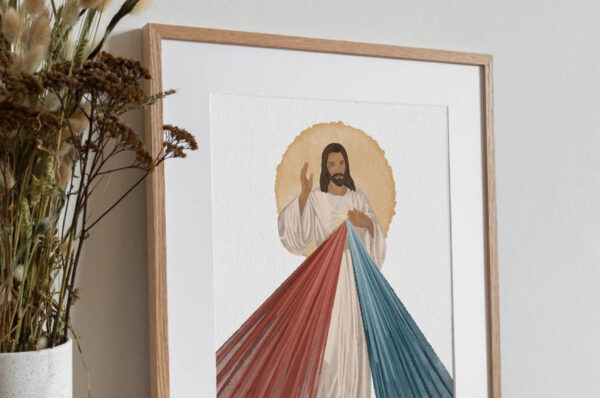There’s a fantastic story about Mother Teresa passing through airport security. As the tiny five-foot-zero saint presented her boarding pass, the security agent dispatched the usual barrage of air travel questions: “Any liquids?” “Explosives?” “Weapons of any kind?” Much to the agent’s surprise, Mother Teresa confirmed that she was, in fact, carrying a weapon! Looking up, Mother opened her wrinkled hand and surrendered her rosary.
The rosary may be familiar to us as our grandparents’ preferred form of prayer. My grandma never went anywhere without her beads. Impressively, she could rattle off 15 decades in a half-hour. Why was it so important to her? She knew what it meant to suffer. She endured World War II, the Great Depression and raised four daughters in the midst of the sexual revolution. My grandma’s daily rosary was her means of placing her family under the Blessed Mother’s mantle. She passed along to my mother and I the importance of praying unceasingly in times when life appears bleak. Today, as Catholics, we face a particularly terrible moment in our Church’s history when spiritual warfare is taking place within. What can we do? The solution rests in our hands.
In the most pivotal times in history, the Blessed Mother appeared asking her children to seek refuge in the prayers of the rosary. Mary’s maternal protection for us is written into the first pages of Scripture. Her role in defeating Satan is predicted in Genesis 3:15, “I will put enmity between you and the woman, and between your offspring and hers; They will strike at your head, while you strike at their heel.” Can we be so bold as Mother Teresa to claim the rosary as our spiritual weapon?
The rosary is essentially a meditation on the words of Sacred Scripture. Its origin dates back to the monastic tradition of praying the Liturgy of the Hours and chanting the 150 Psalms. Illiterate monks were allowed to substitute 150 Our Fathers for reciting the Psalms. The practice eventually spread to lay Catholics who also desired a simpler means of praying the Liturgy of the Hours. In the 12th century, a renewal of Marian devotion contributed to the spread of the Hail Mary prayer. It incorporates the angel Gabriel’s salutation at the Annunciation and Elizabeth’s greeting to Mary, which are both found in the Gospel of Luke.
In an ironic twist of fate, the towering intellectual tradition of the Dominican order became interwoven with the humble rosary from its very beginning in the 13th century. St. Dominic received the rosary in an apparition from the Blessed Mother at a moment when he was feeling frustrated in his efforts to combat the Albigensian heresy. Members of this sect rejected the physical body as evil. Armed with the rosary, St. Dominic encouraged the Albigensians to reflect upon the mysteries of Christ’s Incarnation, life, death and resurrection. It helped them see Jesus as fully human and fully divine. The combination of repetitive Hail Marys and the meditation on the mysteries produced a shocking result, inward conversion of the heretics.
Through Mary’s tender care, the rosary became a nonviolent sword of evangelization.
Thanks to St. Dominic and his order of preachers, pious devotion of the rosary spread and became a source of strength for Catholics. The prayers were especially powerful for those who experienced suffering, trial and persecution. In his work, “The Last Judgment,” Michelangelo included the hopeful image of a man being pulled out of purgatory by rosary beads. In the devastating days of the Black Death, which wiped out nearly a third of Europe’s population, the faithful added a specific request for Mary’s prayers “now” and “at the hour of death.” Over time, this intention became the second half of the Hail Mary. Father Timothy Ratcliffe, O.P. shared recently that when the American Dominicans went to visit China several years ago, they found Dominican laity who survived isolation and persecution by saying the rosary together. It was their “daily bread of survival.”
In 1917, Pope Benedict XV summoned Catholics worldwide to offer a novena to the Queen of Peace calling for an end to World War I. On the eighth day of the novena, the Blessed Mother responded personally to the plea, appearing to three shepherd children in a small village in central Portugal. The messages of Our Lady of Fatima, even now 100 years later, continue to reveal shocking relevance for our modern crisis. Mary’s words were simple and direct. On May 13, Mary shared, “Pray the Rosary every day, in order to obtain peace for the world and the end to war.” On June 13, after the children witnessed a vision of hell, Mary asked them to continue saying the rosary every day and to add the “Oh my Jesus” prayer after each of the mysteries. Over the next four months, Mary continued to instruct the children to pray the rosary daily for peace and to consecrate themselves to the Immaculate Heart of Mary.
It was Mary’s spoken desire at Fatima that the rosary become a part of our own everyday lives. In response to Mary’s request, miracles occurred. In October of 1917, 70,000 people witnessed the miracle of the sun dancing at Fatima. World War I ended within a year. Five years after Pope St. John Paul II granted Mary’s request to consecrate the world to her Immaculate Heart, the Soviet Union fell.
Can we hear the battle cry? What’s the spiritual call of our time? We must join the army of Christ the King and Mary, his Queen Mother. We must cooperate with them in the work of cleansing and purifying our Church.
If we desire peace—peace in our hearts, peace in our families and peace in our world—we must pray the rosary daily. The weapon is in our hands.




